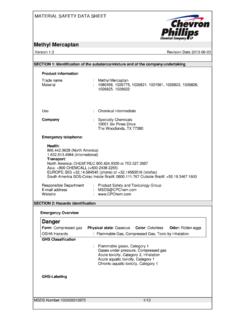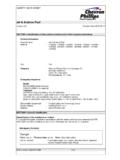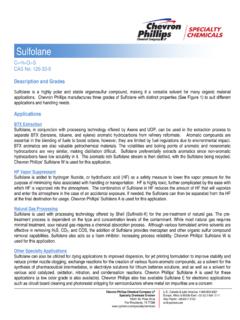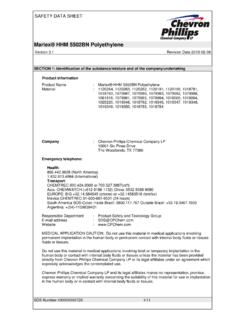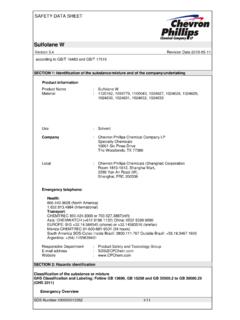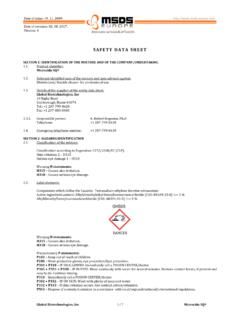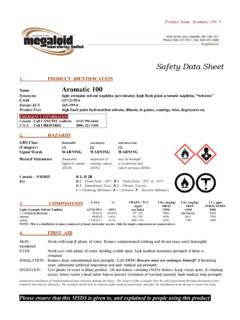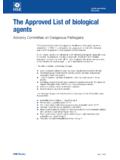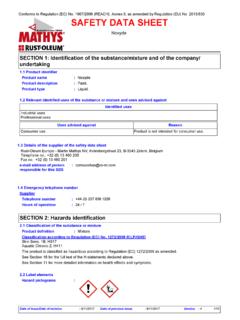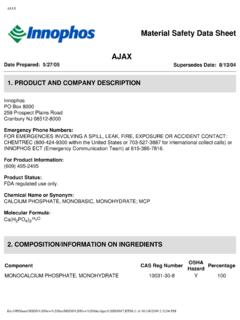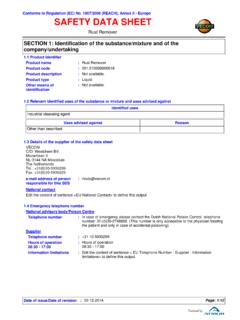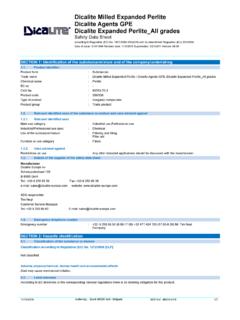Transcription of n-Pentane - Chevron Phillips Chemical
1 SAFETY DATA SHEET n-Pentane Version Revision Date 2014-05-28 msds Number:100000014541 1/13 SECTION 1: Identification of the substance/mixture and of the company/undertaking Product information Trade name : n-Pentane Material : 1113455, 1113456, 1026844, 1026843, 1112936, 1112935, 1111706, 1111587, 1024852, 1016688, 1025132, 1021830, 1026845, 1016689 Use : Solvent Company : Chevron Phillips Chemical Company LP Specialty Chemicals 10001 Six Pines Drive The Woodlands, TX 77380 Emergency telephone: Health: (North America) (International) Transport: North America: CHEMTREC or Asia: +800 CHEMCALL (+800 2436 2255) EUROPE: BIG + (phone) or + (telefax) South America SOS-Cotec Inside Brazil: Outside Brazil: + Responsible Department : Product Safety and Toxicology Group E-mail address : Website : SECTION 2: Hazards identification Classification of the substance or mixture This product has been classified in accordance with the hazard communication standard 29 CFR ; the SDS and labels contain all the information as required by the standard.
2 Emergency Overview Danger Form: Liquid Physical state: Liquid Color: Colorless Odor: Strong gasoline OSHA Hazards : Flammable Liquid, Aspiration hazard, Specific target organ systemic toxicity - single exposure Classification : Flammable liquids, Category 2 Specific target organ systemic toxicity - single exposure, Category 3, Central nervous system SAFETY DATA SHEET n-Pentane Version Revision Date 2014-05-28 msds Number:100000014541 2/13 Aspiration hazard, Category 1 Labeling Symbol(s) : Signal Word : Danger Hazard Statements : H225: Highly flammable liquid and vapor. H304: May be fatal if swallowed and enters airways. H336: May cause drowsiness or dizziness. Precautionary Statements : Prevention: P210: Keep away from heat/sparks/open flames/hot surfaces. - No smoking. P233: Keep container tightly closed. P240: Ground/bond container and receiving equipment. P241: Use explosion-proof electrical/ ventilating/ lighting/ equipment. P242: Use only non-sparking tools.
3 P243: Take precautionary measures against static discharge. P261: Avoid breathing dust/fume/gas/mist/vapors/spray. P271: Use only outdoors or in a well-ventilated area. P280: Wear protective gloves/ eye protection/ face protection. Response: P301 + P310: IF SWALLOWED: Immediately call a POISON CENTER or doctor/ physician. P303 + P361 + P353: IF ON SKIN (or hair): Remove/ Take off immediately all contaminated clothing. Rinse skin with water/ shower. P304 + P340: IF INHALED: Remove victim to fresh air and keep at rest in a position comfortable for breathing. P312: Call a POISON CENTER or doctor/ physician if you feel unwell. P331: Do NOT induce vomiting. P370 + P378: In case of fire: Use dry sand, dry Chemical or alcohol-resistant foam for extinction. Storage: P403 + P233: Store in a well-ventilated place. Keep container tightly closed. P403 + P235: Store in a well-ventilated place. Keep cool. P405: Store locked up. Disposal: P501: Dispose of contents/ container to an approved waste disposal plant.
4 Carcinogenicity: IARC No ingredient of this product present at levels greater than or equal to is identified as probable, possible or confirmed human carcinogen by IARC. NTP No ingredient of this product present at levels greater than or equal to is identified as a known or anticipated carcinogen by NTP. SAFETY DATA SHEET n-Pentane Version Revision Date 2014-05-28 msds Number:100000014541 3/13 ACGIH No ingredient of this product present at levels greater than or equal to is identified as a carcinogen or potential carcinogen by ACGIH. SECTION 3: Composition/information on ingredients Synonyms : n-Pentane (Commercial Grade) n-Pentane (greater than 95%) n-Pentane (Pure Grade) pentane , normal, 95% pentane Amyl hydride Molecular formula : C5H12 Component CAS-No. Weight % n-Pentane 109-66-0 95 - 100 SECTION 4: First aid measures General advice : Move out of dangerous area. Show this material safety data sheet to the doctor in attendance. Symptoms of poisoning may appear several hours later.
5 Do not leave the victim unattended. If inhaled : Move to fresh air. If unconscious place in recovery position and seek medical advice. If symptoms persist, call a physician. In case of skin contact : If skin irritation persists, call a physician. If on skin, rinse well with water. If on clothes, remove clothes. In case of eye contact : Immediately flush eye(s) with plenty of water. Remove contact lenses. Protect unharmed eye. Keep eye wide open while rinsing. If eye irritation persists, consult a specialist. If swallowed : Keep respiratory tract clear. Do NOT induce vomiting. Do not give milk or alcoholic beverages. Never give anything by mouth to an unconscious person. Take victim immediately to hospital. SECTION 5: Firefighting measures Flash point : < -40 C (< -40 F) Method: Tag closed cup Autoignition temperature : C ( F) estimated Suitable extinguishing media : Dry Chemical . Carbon dioxide (CO2). Alcohol-resistant foam.
6 Unsuitable extinguishing : High volume water jet. SAFETY DATA SHEET n-Pentane Version Revision Date 2014-05-28 msds Number:100000014541 4/13 media Specific hazards during fire fighting : Do not allow run-off from fire fighting to enter drains or water courses. Special protective equipment for fire-fighters : Wear self contained breathing apparatus for fire fighting if necessary. Further information : Collect contaminated fire extinguishing water separately. This must not be discharged into drains. Fire residues and contaminated fire extinguishing water must be disposed of in accordance with local regulations. For safety reasons in case of fire, cans should be stored separately in closed containments. Use a water spray to cool fully closed containers. Fire and explosion protection : Do not spray on an open flame or any other incandescent material. Use only explosion-proof equipment. Take necessary action to avoid static electricity discharge (which might cause ignition of organic vapors).
7 Keep away from open flames, hot surfaces and sources of ignition. Hazardous decomposition products : Carbon oxides. SECTION 6: Accidental release measures Personal precautions : Use personal protective equipment. Ensure adequate ventilation. Remove all sources of ignition. Evacuate personnel to safe areas. Beware of vapors accumulating to form explosive concentrations. Vapors can accumulate in low areas. Environmental precautions : Prevent product from entering drains. Prevent further leakage or spillage if safe to do so. If the product contaminates rivers and lakes or drains inform respective authorities. Methods for cleaning up : Contain spillage, and then collect with non-combustible absorbent material, ( sand, earth, diatomaceous earth, vermiculite) and place in container for disposal according to local / national regulations (see section 13). SECTION 7: Handling and storage Handling Advice on safe handling : Avoid formation of aerosol. Do not breathe vapors/dust.
8 Avoid exposure - obtain special instructions before use. Avoid contact with skin and eyes. For personal protection see section 8. Smoking, eating and drinking should be prohibited in the application area. Take precautionary measures against static discharges. Provide sufficient air exchange and/or exhaust in work rooms. Container may be opened only under exhaust ventilation hood. Open drum carefully as content may be under pressure. Dispose of rinse water in accordance with local and national regulations. Advice on protection : Do not spray on an open flame or any other incandescent SAFETY DATA SHEET n-Pentane Version Revision Date 2014-05-28 msds Number:100000014541 5/13 against fire and explosion material. Use only explosion-proof equipment. Take necessary action to avoid static electricity discharge (which might cause ignition of organic vapors). Keep away from open flames, hot surfaces and sources of ignition. Storage Requirements for storage areas and containers : No smoking.
9 Keep container tightly closed in a dry and well-ventilated place. Containers which are opened must be carefully resealed and kept upright to prevent leakage. Observe label precautions. Electrical installations / working materials must comply with the technological safety standards. SECTION 8: Exposure controls/personal protection Ingredients with workplace control parameters US Ingredients Basis Value Control parameters Note n-Pentane OSHA Z-1 TW A 1,000 ppm, 2,950 mg/m3 (b), OSHA Z-1-A TW A 600 ppm, 1,800 mg/m3 OSHA Z-1-A STEL 750 ppm, 2,250 mg/m3 ACGIH TW A 600 ppm, (b) The value in mg/m3 is approximate. Engineering measures Adequate ventilation to control airborned concentrations below the exposure guidelines/limits. Consider the potential hazards of this material (see Section 2), applicable exposure limits, job activities, and other substances in the work place when designing engineering controls and selecting personal protective equipment. If engineering controls or work practices are not adequate to prevent exposure to harmful levels of this material, the personal protective equipment listed below is recommended.
10 The user should read and understand all instructions and limitations supplied with the equipment since protection is usually provided for a limited time or under certain circumstances. Personal protective equipment Respiratory protection : Wear a supplied-air NIOSH approved respirator unless ventilation or other engineering controls are adequate to maintain minimal oxygen content of by volume under normal atmospheric pressure. Wear a NIOSH approved respirator that provides protection when working with this material if exposure to harmful levels of airborne material may occur, such as:. Air-Purifying Respirator for Organic Vapors. Use a positive pressure, air-supplying respirator if there is potential for uncontrolled release, exposure levels are not known, or other circumstances where air-purifying respirators may not provide adequate protection. Hand protection : The suitability for a specific workplace should be discussed with the producers of the protective gloves.
